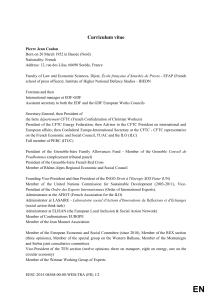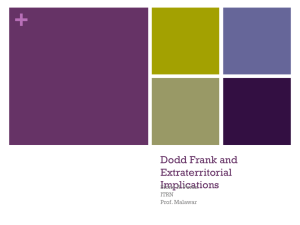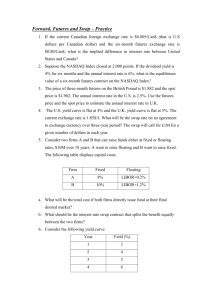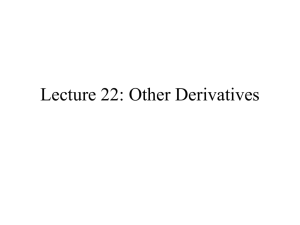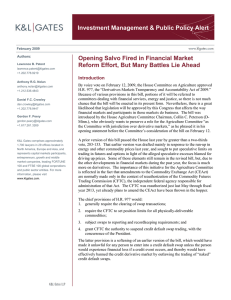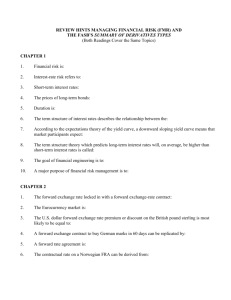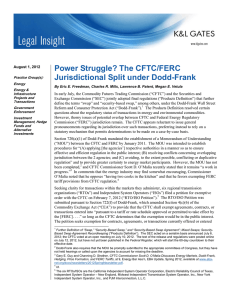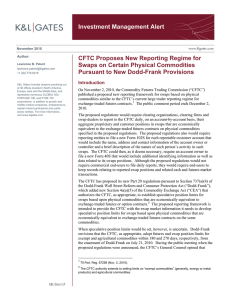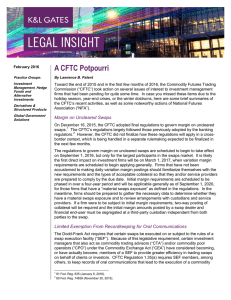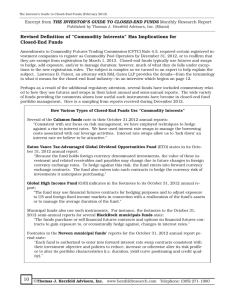Slides: Commissioner Dunn, CFTC
advertisement
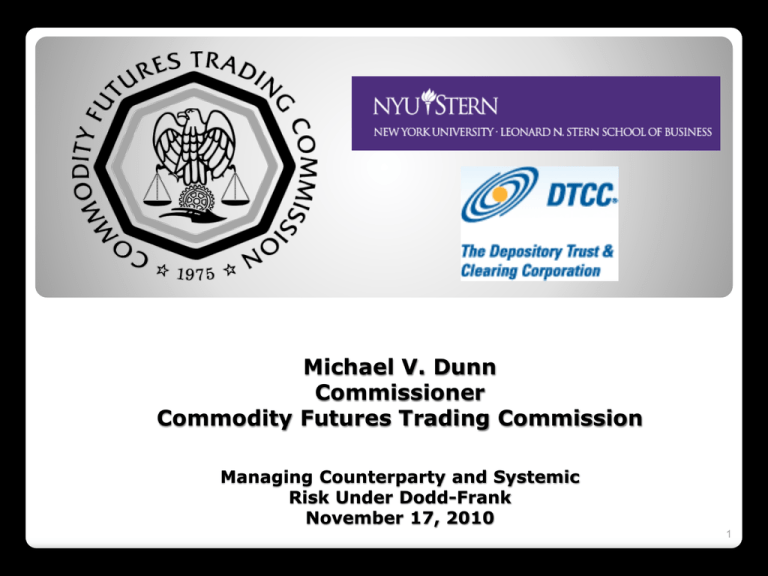
Michael V. Dunn Commissioner Commodity Futures Trading Commission Managing Counterparty and Systemic Risk Under Dodd-Frank November 17, 2010 1 Introduction The CFTC and its Mission ◦ Prior to the Dodd-Frank Act ◦ After passage of Dodd-Frank Act International Coordination ◦ Financial Stability Board ◦ G-20 Seoul Communiqué ◦ IOSCO Task Force on Commodity Futures Markets CFTC Rule Making Process ◦ Deadlines ◦ Solicitation of Public Comments ◦ Implementation and Consultation 2 Commodity Futures Trading Commission Mission Statement To Protect Market Users and the Public from Fraud, Manipulation, and Abusive Practices Related to the Sale of Commodity Futures and Options, and to Foster Open, Competitive, and Financially Sound Commodity Futures and Option Markets. 3 The Commissioners Gary Gensler – Chairman of the Commodity Futures Trading Commission Commissioner Michael V. Dunn – Chairman and Designated Federal Official of the Agricultural Advisory Committee (AAC) Commissioner Jill E. Sommers – Chairperson of the Global Markets Advisory Committee (GMAC) Commissioner Bart Chilton – Chairman of the Energy and Environmental Markets Advisory Committee (EEMAC) Commissioner Scott D. O’Malia – Chairman of the Technology Advisory Committee (TAC) 4 The CFTC Prior to the Dodd-Frank Act 5 CFTC Mandate To Regulate Commodity Futures and Option Markets in the United States The CFTC enables the commodity futures markets to better serve their vital function in the U.S. economy by: ◦ providing a mechanism for price discovery and ◦ a means of offsetting price risks. 6 U.S. Futures Exchanges 2010 CME Group Kansas City Board of Trade Minneapolis Grain Exchange InterContinental Exchange One Chicago CBOE Futures Exchange Chicago Climate Exchange Number of Registered Commodities Professionals Type of Registered Professional Associated Persons (APs) (Sales) Commodity Pool Operators (CPOs) Commodity Trading Advisors (CTAs) Floor Brokers (FBs) Floor Traders (FTs) Futures Commission Merchants (FCMs) Introducing Brokers (IBs) TOTAL Number in 2009 51,921 1,277 2,568 7,114 1,447 166 1,694 66,187 8 The CFTC After the Dodd-Frank Act 9 Objectives of Title VII Reduce systemic risks by: ◦ Comprehensive regulation of swap dealers and major swap participants (i.e. persons other than dealers who may pose systemic risks) ◦ Clearing for standardized swaps ◦ Transparent trading of standardized swaps on regulated swap execution facilities, including real‐time reporting of transaction data ◦ Centralized repository for all swap data, available to all regulators 10 Structure of Title VII Title VII is divided into Subtitles A and B Part I of Subtitle A addresses the division of regulatory authority between the various regulators, and specifically resolves how the CFTC and the SEC may resolve differences between them as to the scope of their respective regulatory authorities. Part II of Title A describes the authority of the CFTC over those transactions that it regulates, defined as “swaps” and “security‐based swap agreements”. Subtitle B describes the authority of the SEC over “security‐based swaps.” The provisions of Part II of Subtitle A and Subtitle B generally are parallel to each other. 11 Clearing Title VII requires that the CFTC will, on an ongoing basis, review swaps and categories or classes of swaps with a view to determining whether clearing should be mandated. Factors to be considered include: the existence of significant outstanding exposures; trading liquidity; and the availability of appropriate operational expertise and resources. Where the CFTC determines that a particular type of swap should be cleared but no clearing organization accepts the swap for clearing, the CFTC may investigate and take appropriate action. 12 End‐User Exception to Clearing The end‐user exception to clearing covers counterparties that: are not financial entities; are using swaps to hedge or mitigate commercial risks; and have notified the CFTC and/or SEC as to how they generally meet their financial obligations associated with non‐cleared swaps. The CFTC is directed to consider whether to exempt depository institutions, farm credit institutions and credit unions with less than $10 billion in assets from the financial entity category. Where clearing is not required, the non‐swap dealer and non‐major swap participant counterparty may nonetheless elect to require that the swap be cleared. The appropriate committee of a public company’s board or governing body must review and approve any decision to rely on an exemption from the mandatory clearing or exchange trading requirements. Special rules for affiliates. 13 Swap Data Repositories Title VII requires swap data repositories to accept data from swap counterparties, confirm the accuracy of that data and maintain the data pursuant to standards to be established by the CFTC, including direct electronic access to the CFTC and systems for monitoring and analyzing data and making information available to regulators. SDRs are required to register with the CFTC and make available on a confidential basis all data obtained by the swap data repository, including individual counterparty trade and position data, to each appropriate prudential regulator, the Council, the SEC, the DOJ, any other person that the CFTC determines to be appropriate, including foreign financial supervisors (including foreign futures authorities), and foreign central banks and foreign ministries. SDRs also are required to establish and maintain emergency procedures, backup facilities, and a plan for disaster recovery that allows for the recovery and restoration of its operations and the timely fulfillment of its responsibilities and obligations. 14 Title I ‐Systemic Risk Regulation Title I of the Dodd‐Frank Act creates the Financial Stability Oversight Council to serve as an early warning system identifying risks in firms and market activities, to enhance oversight of the financial system as a whole and to harmonize prudential standards across agencies. The new Office of Financial Research will serve as the information‐gathering arm of the Council. The Council is empowered to identify “systemically important” nonbank financial companies, thus bringing such companies under regulation by the Federal Reserve, and to recommend heightened prudential standards for the Federal Reserve to impose on these companies. The Council also has the power to recommend heightened prudential standards to primary financial regulators to apply to any activity that the Council identifies as contributing to systemic risk. The Council must seek to resolve supervisory jurisdictional disputes among Council members if certain conditions are satisfied, including at the request of an agency involved. Recommendations by the Council, to be taken by 2/3 vote, are not binding. 15 Financial Stability Board Established in 2009, after London G-20 meeting, to coordinate at the international level the work of national financial authorities and international standard setting bodies to develop and promote the implementation of effective regulatory, supervisory and other financial sector policies. ◦ Comprised of 24 national authorities including all G-20 members. ◦ Secretariat located in Basel, Switzerland Successor to the Financial Stability Forum (FSF), an international forum created in 1999 to enhance cooperation among national and international supervisory bodies to promote stability in the international financial system. 16 G-20 Seoul Communiqué The G-20, which was established in 1999, brings together major industrialized and developing economies to discuss key issues in the global economy. It is the premier forum for international economic discussion on issues related to global economic stability. As chair, Korea hosted the Leaders’ Summit, comprised of the leaders of the G-20 nations, on November 11-12 and published a statement at its conclusion. 17 FSB and Systemic Risk Systemic risk continues to be a focus for the global financial regulatory community. ◦ In the Seoul Communiqué, the G-20 Leaders endorsed the Financial Stability Board’s (FSB) policy framework that will subject these systemically important financial institutions (SIFIs) to “liquidity surcharges, tighter large exposure restrictions, levies and structural measures.” ◦ By mid-2011 the FSB, along with national authorities, will identify globally-active SIFIs and plans to identify additionally requirements for these institutions by December 2011. 18 Over-the-counter Derivatives Market regulators also have been increasing their international coordination to limit the risk posed by the over-the-counter (OTC) derivatives market. At the 2009 Pittsburgh Summit, the G-20 Leaders declared that all standardized OTC derivative contracts should be cleared through central counterparties by the end of 2012. Additionally, all OTC derivative contracts should be reported to trade repositories. 19 Commodity Price Volatility Volatile commodity prices increase uncertainly and could inhibit global economic recovery. To combat this risk, the G-20 Leaders called on the IOSCO Task Force on Commodity Futures Markets, which is cochaired by the CFTC, to develop further work on the regulation and supervision of the commodity derivatives markets and to report to the FSB its next steps in April 2011. Query – Is U.S. timeline to far in front of other regulators? 20 International Cooperation CFTC has a long history of international coordination with foreign regulators This international outreach has intensified since the passage of the Dodd-Frank Act. ◦ Regular calls with European Commission directors to harmonize rules. ◦ Solicitation of comments on rules from the European Commission, UK FSA and Japan FSA. 21 Memoranda of Understanding CFTC has entered into: Regulatory memoranda of understanding (MOUs) with regulators in key major market jurisdictions. Enforcement MOUs including the IOSCO Multilateral MOU Concerning Consultation and Cooperation and the Exchange of Information (2002) as well as bilateral MOUs with foreign regulators. Boca Raton Declaration on Cooperation and Supervision of International Futures Markets and Clearing Organisations (1996) Specifically for sharing information if certain triggering events occur that affect exchange members financial resources or large exposures. 22 Overview of the Dodd-Frank Rulemaking Process 23 General Requirements Some of the rulemakings are mandatory, some discretionary and joint with the SEC Some of the rules require coordination with other Federal regulators and some require consultation (e.g., consult and coordinate with the SEC, the Fed and the prudential regulators before commencing any rulemaking regarding swaps…) 24 Deadlines The rulemakings have various deadlines –the global deadline is 360 days after enactment. Some rules have a 90 day deadline, e.g., retail forex Some rules have a 180 day deadline, e.g., position limits for exempt commodities and conflicts of interest and governance Some rules have a 270 day deadline, e.g., position limits for agricultural commodities 25 Deadlines Some rules have a one year deadline, e.g., swap dealer and major swap participation registration The longest deadline for rulemaking is 24 months for the joint recordkeeping rules under Title 2 26 Process Staff charted all the rulemakings from Dodd‐Frank These rules were then clustered in 30 groups Each group was assigned a team leader Each team was then populated with appropriate staff from the Commission’s Divisions and Offices 27 MOUs, Reports, Studies Dodd‐Frank also requires the Commission to do more than just rulemakings ◦ 2 Memoranda of Understanding with FERC (avoiding conflicting and duplicative regulation and information sharing) ◦ 5 reports (e.g., abusive swaps, growth or decline of derivatives markets in the US and abroad) ◦ 6 studies (e.g., position limits, swap and clearing regulation in the US, Asia and Europe) 28 Solicitation of Public Comments Staff has created mail boxes for each of the 30 rulemakings on the Commission’s web site to receive comments from the public on the rulemakings prior to publishing the proposed rules In addition, the Commission has issued a Federal Register release that also solicits comments from the public on the rulemakings prior to publishing the proposed rules 29 Solicitation of Public Comments 30 Implementing Dodd-Frank Two Principles We Are Following: 1. comply fully with the statute’s provisions and Congressional intent to lower risk and bring transparency to these markets 2. consult heavily with both other regulators and the broader public, including many participants in the futures markets 31 Consultation with Fellow Regulators CFTC staff and Commissioners have had nearly 200 meetings with our fellow regulators on Dodd-Frank implementation Consulting with international regulators to harmonize our approach to swaps oversight 32 Public Input Staff or Commissioners have at least 325 meetings with individuals from the public regarding swaps regulation Transparent rule-writing efforts ◦ Website postings of all meetings, participants, discussions, and materials received ◦ Publishing proposed rules ◦ To date - four public meetings regarding 17 proposed rules ◦ In total – there will be close to 100 proposed rules 33 Public Meeting 11/19 The Commission will hold its 5th public meeting to implement rules pursuant to Dodd-Frank on November 19th. The rules that will be considered include: 1. 2. 3. 4. Swap data repositories; Real-time public reporting of swap transaction data; Data recordkeeping; and Protection of collateral of counterparties to uncleared swaps, and treatment of securities in a portfolio margining account in a commodity broker bankruptcy 34 Conclusion Congressional mandate to establish rules to implement Dodd-Frank by July 15, 2011 Two paths to follow: 1. 2. Set an example for the rest of the world to follow by developing carefully crafted rules that address the abuses that led to the financial meltdown; or Develop rules that are too timid to prevent another financial crisis or too restrictive and possibly drive business to less regulated markets. The choice is truly in the hands of the public. The Commission will not be making final decisions until the public has had the opportunity to comment on all of these rules. 35 Thank You! Questions? 36
